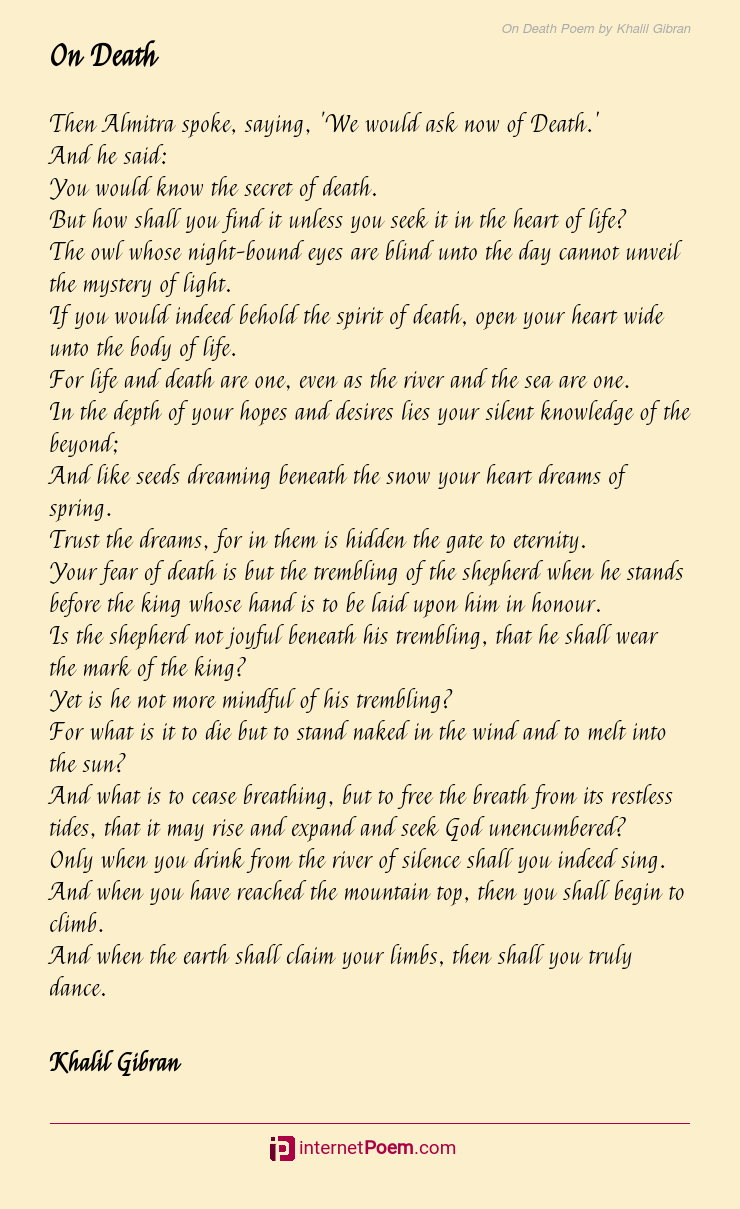Kahlil Gibran On Death: Quotes & Reflections
What is the nature of death? Is it an ending, a beginning, or something else entirely? Kahlil Gibran, the celebrated Lebanese-American poet and philosopher, believed death was not an adversary to be feared, but a natural transition woven into the very fabric of existence. His perspective, imbued with profound spiritual insight, offers solace and a unique understanding of life's ephemeral journey.
Gibrans exploration of mortality wasnt rooted in morbidity, but rather a deep appreciation for the interconnectedness of life and death. He viewed death not as a cessation of being, but a transformation, a shedding of the earthly form to embrace a different realm of existence. This resonates powerfully in his seminal work, The Prophet, first published in 1923. Within its poetic prose, Almitra poses the question of death to the prophet Almustafa, prompting a discourse that illuminates death's mysteries and reassures the heart. You would know the secret of death, Almustafa responds. But how shall you find it unless you seek it in the heart of life?
| Full Name: | Gibran Khalil Gibran (Arabic: ) |
| Born: | January 6, 1883, Bsharri, Lebanon (then part of the Ottoman Empire) |
| Died: | April 10, 1931 (aged 48), New York City, USA |
| Cause of Death: | Cirrhosis of the liver and tuberculosis |
| Occupation: | Poet, writer, philosopher, visual artist |
| Key Works: | The Prophet (1923), The Madman (1918), Broken Wings (1912), Spirits Rebellious (1908) |
| Languages: | Arabic, English |
| Notable Themes: | Life, death, love, spirituality, religion, society |
| Reference: | Poetry Foundation |
Born in the mountainous village of Bsharri, Lebanon, Gibran's early life was marked by simplicity and a lack of formal education. Yet, this seemingly barren landscape nurtured a profound spiritual sensibility within him. He immigrated to the United States with his family in 1895, settling in Boston, a city that would become a crucible for his artistic development. While he received some formal schooling in Boston, his deep connection to his Lebanese heritage remained a wellspring of inspiration throughout his life.
Gibran's artistic expression flowed through multiple channels. He was a gifted visual artist, producing drawings and paintings imbued with a mystical quality that mirrored the themes explored in his writing. His literary output, initially predominantly in Arabic, later transitioned primarily to English, expanding his reach and influence. He achieved significant recognition on both sides of the Atlantic, a testament to the universal resonance of his philosophical musings.
Gibrans perspective on death finds eloquent expression in the chapter On Death within The Prophet. Almitra's inquiry prompts Almustafa to unveil deaths profound connection to life itself. He challenges the conventional notion of death as an ending, urging us to seek its secrets not in the shadows of the grave, but within the vibrant pulse of life. If you would indeed behold the spirit of death, he implores, open your heart wide unto the body of life.
This potent imagery encourages a shift in perception. Death is not an antagonist, but an integral part of life's grand cycle. Just as a river flows into the sea, life transitions into death, a seamless continuation rather than an abrupt termination. Gibrans words invite us to embrace the full spectrum of human experience, understanding that death is not a negation of life, but its inevitable counterpart.
This philosophy is further elaborated in Gibran's evocative imagery: For what is it to die but to stand naked in the wind and to melt into the sun? This paints a picture not of oblivion, but of a liberating release, a merging with the elemental forces of nature. To cease breathing, in Gibran's view, is not an ending, but a freeing of the breath from its earthly constraints, allowing it to rise and expand and seek God unencumbered.
Gibrans writings on death provide profound comfort to those grappling with grief and loss. He reframes death not as a tragic finality, but as a transition to a different state of being. By linking death so closely to life, he diminishes its power to instill fear, allowing us to approach it with a sense of acceptance and even reverence.
Even after his death at the relatively young age of 48, Gibrans words continue to resonate with generations of readers. His insights into the human condition, particularly his reflections on death and the spiritual realm, offer a timeless wisdom that transcends cultural and religious boundaries. He reminds us that the search for the meaning of death is intertwined with the search for the meaning of life, and that true understanding lies not in fearing the inevitable, but in embracing the totality of our existence.
The enduring legacy of Kahlil Gibran lies in his ability to articulate complex philosophical concepts in accessible, poetic language. His exploration of death offers a profound and comforting perspective, reminding us that while life is fleeting, the spirit endures, transcending the limitations of our earthly existence.


